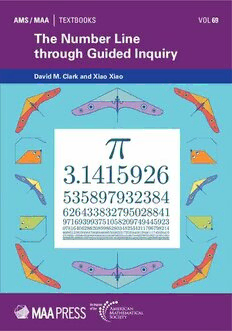
The Number Line through Guided Inquiry PDF
Preview The Number Line through Guided Inquiry
AMS / MAA TEXTBOOKS VOL 69 The Number Line through Guided Inquiry David M. Clark and Xiao Xiao π The Number Line through Guided Inquiry AMS/MAA TEXTBOOKS VOL 69 The Number Line through Guided Inquiry David M. Clark Xiao Xiao MAATextbooksEditorialBoard WilliamR.Green,Co-Editor SuzanneLynneLarson,Co-Editor PaulT.Allen MarkBollman DebraS.Carney HughN.Howards WilliamJohnston EmekKose MichaelJ.McAsey ThomasC.Ratliff PamelaRichardson JeffreyL.Stuart RonTaylor RuthVanderpool ElizabethWilcox 2020MathematicsSubjectClassification. Primary97E50,97F50,97I99,01A65. Foradditionalinformationandupdatesonthisbook,visit www.ams.org/bookpages/text-69 LibraryofCongressCataloging-in-PublicationData Names:Clark,DavidMichael,1947-author.∣Xiao,Xiao,1983-author. Title:Thenumberlinethroughguidedinquiry/DavidM.Clark,XiaoXiao. Description: Providence,RhodeIsland: AmericanMathematicalSociety,[2022]∣Series: AMS/MAAtext- books,2577-1205;volume69∣Includesbibliographicalreferencesandindex. Identifiers:LCCN2021034782∣ISBN9781470465049(paperback)∣9781470467999(ebook) Subjects: LCSH:Science–Studyandteaching∣Mathematics. ∣AMS:Mathematicseducation–Education offoundationsofmathematics–Reasoningandprovinginthemathematicsclassroom. ∣Mathematics education–Educationofarithmeticandnumbertheory–Realnumbers,complexnumbers(educational aspects).∣Mathematicseducation–Analysiseducation–Noneoftheabove,butinthissection.∣History andbiography–Historyofmathematicsandmathematicians–Developmentofcontemporarymathe- matics. Classification:LCCQ181.C4952022∣DDC510.71/2–dc23 LCrecordavailableathttps://lccn.loc.gov/2021034782 Copyingandreprinting. Individualreadersofthispublication,andnonprofitlibrariesactingforthem, arepermittedtomakefairuseofthematerial,suchastocopyselectpagesforuseinteachingorresearch. Permissionisgrantedtoquotebriefpassagesfromthispublicationinreviews,providedthecustomaryac- knowledgmentofthesourceisgiven. Republication,systematiccopying,ormultiplereproductionofanymaterialinthispublicationispermit- tedonlyunderlicensefromtheAmericanMathematicalSociety.Requestsforpermissiontoreuseportions ofAMSpublicationcontentarehandledbytheCopyrightClearanceCenter. Formoreinformation,please visitwww.ams.org/publications/pubpermissions. Sendrequestsfortranslationrightsandlicensedreprintstoreprint-permission@ams.org. ©2022bytheAmericanMathematicalSociety.Allrightsreserved. TheAmericanMathematicalSocietyretainsallrights exceptthosegrantedtotheUnitedStatesGovernment. PrintedintheUnitedStatesofAmerica. ⃝1Thepaperusedinthisbookisacid-freeandfallswithintheguidelines establishedtoensurepermanenceanddurability. VisittheAMShomepageathttps://www.ams.org/ 10987654321 272625242322 Contents Preface vii To the Student xvii Acknowledgement xxi 1 Rational Numbers and Missing Numbers 1 1.1 Integers 2 1.2 RationalNumbers 3 1.3 MissingNumbers 4 1.4 NumberLines 7 1.5 ManyNumberLines 9 1.6 HistoricalNote: OtherMissingNumbers 10 2 Limit Points and Sequences 13 2.1 IntervalsandLimitPoints 15 2.2 SequencesandConvergence 16 2.3 HistoricalNote: Zeno’sParadox 19 3 Decimal Representations of Numbers 21 3.1 InfiniteDecimalRepresentations 22 3.2 RationalNumbersasInfiniteDecimals 24 3.3 ExistenceandUniqueness 27 3.4 HistoricalNote: TheHindu-ArabicNumerals 30 4 Complete Number Lines 35 4.1 TheCompletenessAxiom 36 4.2 TheSquareRootof17 37 4.3 HistoricalNote: TheArchimedeanDilemma 38 5 Continuity 41 5.1 DefinitionsandExamples 42 5.2 GeneratingContinuousFunctions 46 5.3 MissingNumbersasIntermediateValues 47 5.4 UniformContinuity 49 5.5 HistoricalNote: ContinuityviaInfinitesimals 51 v vi Contents 6 Calculus 53 6.1 Integrals 54 6.2 Derivatives 58 6.3 TheFundamentalConnection 61 6.4 HistoricalNote: CalculusviaInfinitesimals 62 7 Log and Exponential Functions 65 7.1 RationalExponents 66 7.2 NaturalLogarithm 67 7.3 ExponentsRevealMoreMissingNumbers 69 7.4 HistoricalNote: The19th-CenturyTransition 72 8 The Real Number Line 75 8.1 TheNon-NegativeRealNumbersℝ 76 ≥0 8.2 TheRealNumberLineℝ 85 8.3 AllNumberLines 89 8.4 HistoricalNote: TheHyperrealNumbers 90 9 The Price of Completeness 93 9.1 Cantor’sSetTheory 94 9.2 Lebesgue’sMeasureTheory 97 9.3 HistoricalNote: MoreInfinities! 98 A Historical Summary 101 B The Reals via Dedekind Cuts 105 B.1 RationalandGhostDownsets 106 B.2 ConstructionoftheNumberLine 107 B.3 RationalandIrrationalNumbers 112 C Guidelines for the Instructor 115 C.1 ChapterOptions 115 C.2 TeachingthroughGuidedInquiry 116 Bibliography 121 Index 123 Preface This book is designed as a replacement for conventional real analysis for fu- turemathematicsteachers. Therealnumbersystemandfunctionsonthereal numbersarecentraltoolsfortheunderstandingofawiderangeofquantitative subjects. Consequently these topics are taught to high school and beginning college students, even though these students are not yet prepared to under- stand them in any significant depth. This text will give future teachers both that depth of understanding and the pedagogical and communication skills thatcomewithguidedinquirylearning. Itisnotintendedtopreparestudents forgraduatestudyinmathematicswherethecontentsofatraditionalrealanal- ysiscourseareneeded. Inspiteofitsphysicallyleanpresentation,thistextiswrittenforaone,two orthreesemestercoursesequencedependingonhowfarstudentswanttogo with it. Generally it will be the most advanced undergraduate mathematics course they will have. In preparation for using this book, we advise that stu- dentshaveayearofcalculusandanintroductorycoursethatfamiliarizesthem withthebasicpropertiesoftheintegersandrationalnumbers,propertiesofsets andmathematicalinduction. Agoodprevioustheoremprovingcourselikeax- iomaticgeometrywouldverymuchenhancetheirabilitytogofurtherintothis book. Thisbookwasdesignedtofulfillthreegoals. ● ReasoningandProof. Asisneededineverydiscipline,itwillhelpstudents develop a mastery of the particular methodology used in mathematics to determinewhatistrue. ● Active Learning. It will guide students in proving theorems and solving problems by having them prove theorems and solve problems, and then present their results for feedback and discussion with the instructor as a mentor. ● Content. It will provide students with a working knowledge of just that part of real analysis that directly underlies the material on numbers and functionsthattheywillteachinhighschool. Ourthreegoalsforfutureteachers,originallyarticulatedin[6],lackedwide spreadsupportuntilveryrecently. Theyarenowfullyconsistentwiththemost currentrecommendationsoftheprofessionalmathematicscommunity. vii viii Preface Ournationalstandardsforcollegemathematicsinstructionandforteacher preparation in mathematics fall under the purview of the Conference Board fortheMathematicalSciences. TheCBMS,formallyincorporatedin1960,de- scribesitselfas“anumbrellaorganizationconsistingofseventeenprofessional societies all of which have as one of their primary objectives the increase or diffusionofknowledgeinoneormoreofthemathematicalsciences.” In 2001 the CBMS published a manual, The Mathematical Education of Teachers,withspecificrecommendationsfortheteachingrealanalysis[7,pp. 42–43]. These recommendations reflected the view of teaching mathematics thathadbeendominantinovertheprevioustwodecades. Thisviewsawmath- ematicsprimarilyasacollectionoftoolstosolveproblemsinscienceanden- gineering. Teacherswereexpectedtolearn as manyof these toolsas possible sothattheywouldbeabletopassthemontotheirownclasses. Since2001anumberofdevelopmentshaveledthemathematicscommu- nity to make some significant modifications of those recommendations. In 2012theCBMSissuedanupdatedTheMathematicalEducationofTeachersII [8]. Readingthisrevisedmanual,wewerepleasedtoseethattheyhadincor- porated these new developments and aligned their recommendations for un- dergraduate mathematics instruction and teacher preparation with the three abovegoalsthathadbeenusedfortheinitialdraftofthismanuscript. We would like to outline the genesis of these new developments and cite the parts of the 2012 CBMS recommendations that pertain to the teaching of real analysis and to our three central goals for teacher preparation. We will then identify a wider audience for the book and end with a summary of the sequenceofchapters. AppendixCwillgiveavarietyofsuggestionsastohow thisbookcanbeused. 1. ReasoningandProof Eachdisciplinehasitsownparadigmforestablishingtruth,beitlaboratory experiments,statisticalanalysisofdataormaybesubjectivearguments. What- evertheparadigm,collegelevelmasteryofasubjectshouldincludeamastery of its method of establishing truth. In mathematics we establish a statement tobetruebygivingaproof. Mathematicsgraduateswithaproficiencyinprov- ingtheoremswill,withsufficientbackgroundknowledge,beabletofigureout whatisandisnotmathematicallytruebythemselves,andwillbeabletocrit- ically judge the validity of what they hear. These skills extend well beyond mathematicsperse. In2012thenewCBMSrecommendationsincludedastrongendorsement oftheReasoningandProof goalpursuedinthistext[8,p. 56]. Experiencewithreasoningandproof. Reasoningisessentialforall mathematicalprofessions,especiallyforteaching. Makingsenseofmath- ematicsmakesiteasiertounderstand,easiertoteach,andintellectually satisfying for all students, including high school students who have no Preface ix intention of going into technical fields. And proof is essential to all of mathematics. Accordingly,reasoningandproof,whileitisoftenthefo- cusofaparticularcourse,shouldbepresent,notalwaysatthesamelevel ofrigor,inmostundergraduatecourses. 2. ActiveLearning How,then,dowebestteachreasoningandproof? Thetraditionalresponse was to explain and demonstrate these concepts through clear and well orga- nizedlectures. Ontheotherhand,itiswidelyacknowledgedthatlearningto ride a bicycle or play the piano is best achieved by directly engaging in those activities. In recent years there has been a growing awareness that the same principleappliestoalllearning. Inordertoestablishtruthintheirdiscipline, collegestudentsmustdotheexperiments,carryoutthestatisticalanalysesor makethesubjectivearguments. Oursecondgoalistousethesamepedagogy, broadlyknownasactivelearning. Traditionalteachingfocusesattentiononinstructors,whosejobitistodis- seminatetheirknowledgeandexpertisetothestudents. Activelearningshifts the roles of instructors and students, putting the students at the center of the learningprocess. Itistheinstructor’stasktoguidethestudentstowardagoal that they have the tools to achieve but have not been told how to achieve. It isthestudent’stasktocarryoutaninvestigationbyinquiringintodifferentas- pectsofthegoalinordertobuildanunderstandingofitscontextuntilthatgoal is achieved. The use of active learning in mathematics has gone under many names,1 eachreflectingadifferentimplementationofthispedagogy. Wefind thephraseguidedinquirylearning (GIL)tobeagoodgeneraltermforallim- plementationsofactivelearninginmathematics,asitrefersdirectlytotherole oftheinstructor(aguide)andtheactivityofthestudents(toinquire). In1998HarryLucas’AustinbasedEducationalAdvancementFoundation beganholding annual meetings tosupport theuse and dissemination of GIL. WithoutthefundingandinspirationfromMr. Lucasthismovementwouldnot bewhereitistoday. In2009theMathematicsAssociationofAmerica(MAA), ourprimarystewardofundergraduatemathematicsteaching,publishedatext ontheuseofGILbyCoppin,Mahavier,MayandParker[9]. In2011theMAA became a joint sponsor of the annual EAF conferences, thereby officially en- dorsingtheGILmovement. Also in 2011 Sandra Laursen [16] reported on a large scale control study donebyherteamattheUniversityofColoradoBoulderthatdocumentedthe effectivenessofGIL(IBL)attheuniversitylevel. Itrevealedsignificantbene- fitsrealizedbystudentsinGILclassesoverthoseinnon-GILclasses,withthe greatest improvements shown for women and traditionally under achieving groups;see[23],[15]and[16,p. xii,ES10.0]. 1Texasmethod, Mooremethod, modifiedMooremethod, inquiry-basedlearning, guided inquirylearning,learningbyinquiry,inquiryorientedinstruction,…
